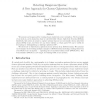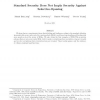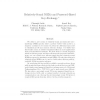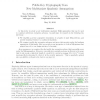118
Voted
EUROCRYPT
2012
Springer
13 years 3 months ago
2012
Springer
We present a new approach for creating chosen ciphertext secure encryption. The focal point ork is a new abstraction that we call Detectable Chosen Ciphertext Security (DCCA). Int...
134
Voted
EUROCRYPT
2012
Springer
13 years 3 months ago
2012
Springer
We provide an alternative method for constructing lattice-based digital signatures which does not use the “hash-and-sign” methodology of Gentry, Peikert, and Vaikuntanathan (ST...
142
Voted
EUROCRYPT
2012
Springer
13 years 3 months ago
2012
Springer
We describe a compression technique that reduces the public key size of van Dijk, Gentry, Halevi and Vaikuntanathan’s (DGHV) fully homomorphic scheme over the integers from ˜O(�...
EUROCRYPT
2012
Springer
13 years 3 months ago
2012
Springer
135
Voted
EUROCRYPT
2012
Springer
13 years 3 months ago
2012
Springer
sion of an extended abstract published in Proceedings of Eurocrypt 2012, Springer-Verlag, 2012. Available from the IACR Cryptology ePrint Archive as Report 2012/012. Malleability ...
106
Voted
PKC
2012
Springer
13 years 3 months ago
2012
Springer
We define a new notion of relatively-sound non-interactive zeroknowledge (NIZK) proofs, where a private verifier with access to a trapdoor continues to be sound even when the Ad...
153
Voted
PKC
2012
Springer
13 years 3 months ago
2012
Springer
We initiate the study of security for key-dependent messages (KDM), sometimes also known as “circular” or “clique” security, in the setting of identity-based encryption (I...
126
Voted
PKC
2012
Springer
13 years 3 months ago
2012
Springer
ded abstract of this work will appear in Public Key Cryptography — PKC 2012. This is the full version. We propose a general framework that converts (ordinary) signature schemes ...
124
Voted
PKC
2012
Springer
13 years 3 months ago
2012
Springer
In this work, we study a new multivariate quadratic (MQ) assumption that can be used to construct public-key encryption schemes. In particular, we research in the following two di...
PKC
2012
Springer
13 years 3 months ago
2012
Springer
We revisit the definition of unforgeability of blind signatures as proposed by Pointcheval and Stern (Journal of Cryptology 2000). Surprisingly, we show that this established de�...




